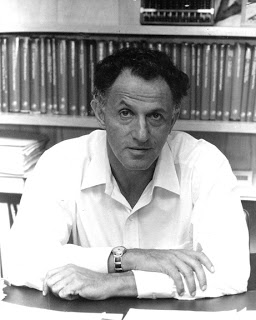Richard E. Bellman facts for kids
Quick facts for kids
Richard Ernest Bellman
|
|
|---|---|
 |
|
| Born |
Richard Ernest Bellman
August 26, 1920 New York City, New York, U.S.
|
| Died | March 19, 1984 (aged 63) Los Angeles, California, U.S.
|
| Alma mater | Princeton University Johns Hopkins University University of Wisconsin Brooklyn College |
| Known for | Dynamic programming Stochastic dynamic programming Curse of dimensionality Linear search problem Bellman equation Bellman–Ford algorithm Bellman's lost in a forest problem Bellman–Held–Karp algorithm Grönwall–Bellman inequality Hamilton–Jacobi–Bellman equation |
| Awards | John von Neumann Theory Prize (1976) IEEE Medal of Honor (1979) Richard E. Bellman Control Heritage Award (1984) |
| Scientific career | |
| Fields | Mathematics and Control theory |
| Institutions | University of Southern California Rand Corporation Stanford University |
| Thesis | On the Boundedness of Solutions of Non-Linear Differential and Difference Equations |
| Doctoral advisor | Solomon Lefschetz |
| Doctoral students | Christine Shoemaker |
Richard Ernest Bellman (born August 26, 1920 – died March 19, 1984) was an American mathematician. He is famous for creating "dynamic programming" in 1953. This is a special way to solve complex problems by breaking them down into smaller, easier steps. He also made important contributions to other areas of mathematics, including how math can be used in biology. He even started a top journal called Mathematical Biosciences.
Contents
About Richard Bellman's Life
Richard Bellman was born in 1920 in New York City. His parents ran a small grocery store. He went to Abraham Lincoln High School in Brooklyn. He loved mathematics and studied it at Brooklyn College, earning his first degree in 1941. Later, he got another degree from the University of Wisconsin.
During World War II, Bellman worked on a special project in Los Alamos. This was a very important time for science. In 1946, he earned his Ph.D. from Princeton University. His teacher there was Solomon Lefschetz. Starting in 1949, Bellman worked for many years at the RAND Corporation. It was during this time that he developed his famous idea of dynamic programming.
Later in his life, Richard Bellman became very interested in biology and medicine. He believed these were the "frontiers of contemporary science." In 1967, he became the first editor of the journal Mathematical Biosciences. This journal quickly became, and still is, very important in the field of mathematical biology. In 1985, the Bellman Prize in Mathematical Biosciences was created in his honor. This award is given every two years for the best research paper in the journal.
In 1973, Bellman was diagnosed with a brain tumor. It was removed, but it caused health problems that made him severely disabled. Despite this, he continued his work. He was a professor at the University of Southern California. He was also recognized as a Fellow in the American Academy of Arts and Sciences in 1975. In 1977, he became a member of the National Academy of Engineering. In 1983, he joined the National Academy of Sciences.
In 1979, he received the IEEE Medal of Honor. This award was given for his work on decision-making and control systems. It especially recognized his creation and use of dynamic programming. His most important work includes the Bellman equation, which is a key part of dynamic programming.
Richard Bellman's Key Ideas
What is the Bellman Equation?
The Bellman equation is also known as a "dynamic programming equation." It's a necessary rule for finding the best possible solution when using dynamic programming. If you have a problem that can be solved with optimal control theory, you can often solve it by looking at the right Bellman equation. This equation was first used in engineering and other areas of applied mathematics. Later, it became a very important tool in economics.
Understanding the Hamilton–Jacobi–Bellman Equation
The Hamilton–Jacobi–Bellman equation (HJB) is a special type of mathematical equation. It is central to optimal control theory. The solution to the HJB equation tells you the "value function." This function helps you find the best way to control a system to get the lowest cost. Old math problems, like the brachistochrone problem (finding the fastest path for a ball to roll down), can be solved using this method. This equation comes from Bellman's dynamic programming theory from the 1950s. The Bellman equation is used for problems that change step-by-step. The HJB equation is for problems that change continuously over time. It builds on earlier work in physics by William Rowan Hamilton and Carl Gustav Jacob Jacobi.
What is the Curse of Dimensionality?
The "curse of dimensionality" is a phrase Bellman created. It describes a problem that happens when you add more dimensions to a mathematical space. Imagine you have a line (one dimension). It's easy to pick 100 points on it. Now imagine a square (two dimensions). You'd need 100x100 = 10,000 points to cover it with the same closeness. If you go to 10 dimensions, you'd need 100 to the power of 10 points! This huge increase in "size" makes some computer calculations much harder. For example, solving the Bellman equation can take much longer if there are many variables.
How the Bellman–Ford Algorithm Works
The Bellman–Ford algorithm is a way to find the shortest path from one starting point to all other points in a network. This network can have "edges" (connections) with negative weights. This means some paths might make the total distance smaller. Another algorithm, Dijkstra's algorithm, does a similar job but is faster. However, Dijkstra's algorithm can only work if all the edge weights are positive (no negative paths).
See also
 In Spanish: Richard Bellman para niños
In Spanish: Richard Bellman para niños

